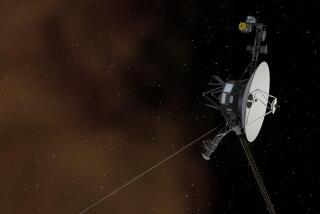Touchy Telescope Torments Controllers : Space: Scientists encounter ‘more problems than we anticipated,’ but they are still confident.
- Share via
GREENBELT, Md. — The Hubble Space Telescope spent its first full day in orbit Thursday tormenting the engineers and scientists on the ground who would be its masters.
As it orbited 381 miles above the Earth, 50 miles in front of the shuttle Discovery, the $1.5 billion telescope balked at communicating with ground controllers and played the leading role in a series of dramas that had the experts gnawing on their fingernails.
“I feel like we’ve had a lot more problems than we had anticipated,” said Michael M. Harrington, director of orbital verification at the Goddard Space Flight Center here. But he quickly added that he is “confident” that he and his fellow engineers will prevail.
The most threatening problem began just as Harrington was showing up for work. The previous shift had failed in its attempts to establish communications with the telescope through its twin high-gain antennas. The telescope also has a secondary communications system, but the high-gain antennas will be the primary means for transmitting scientific data back from the telescope, and the loss would have been catastrophic.
Harrington’s team determined that the communications link had failed because the telescope probably was not pointing exactly where they thought it was, and thus the antennas were not pointing at the sophisticated communications satellite that serves as NASA’s link to its space vehicles.
The orientation of the telescope is determined partly by “fixed star trackers,” small telescopes on board the Hubble that reveal the locations of various stars whose positions are well known. That information tells ground controllers how much and which way to move the telescope so that it is pointing in the right direction.
After analyzing data from the star trackers, controllers ordered the telescope to move and the antennas locked on the communications satellite and the vital link was completed.
Then a problem cropped up with the secondary communications system which allows the telescope to accept orders from the ground.
That left ground controllers wondering about how they were going to order the telescope to do anything at all, but within a few tense minutes that problem was resolved too. Engineers determined that it was a human failure on the ground, not a hardware failure in orbit, that caused the problem.
The problems came at the very beginning of what will be a long process--testing and fine tuning the guidance system that will allow astronomers to study distant objects for long periods.
The telescope has the finest mirror ever produced, but it would be useless without a guidance system that will point the telescope at specific targets and hold it “locked on” for hours. Controllers are expected to work for months getting the guidance system perfected.
“It is the requirement to point very precisely that makes the checkout period so long,” said Steve Terry, an orbital verification official at Goddard. “This is the first baby step.”
Normally, satellites use tiny jets to keep them properly oriented, but even the smallest jets would foul the neighborhood around the space telescope, thus negating the reason for putting it in orbit above the atmosphere.
The telescope uses four large flywheels to move it. As each flywheel spins, the telescope tends to rotate in the direction of the spinning. It works the other way around just as well. Thus controllers can move the telescope in any direction just by controlling the spin of the flywheels. But Thursday, while engineers were still getting acquainted with their new toy, one of the flywheels stopped. It was later restarted after engineers determined that the problem was simply a faulty sensor.
Without at least three of the four flywheels, it would not be possible to point the telescope accurately, so the problem caused a lot of consternation here for awhile.
How accurate does the pointing have to be? To within .007 seconds of arc, said Edward J. Weiler, program scientist at NASA headquarters.
“That’s equivalent to if you had a laser beam in Washington and you fired it at New York, you would be able to hit a dime,” Weiler said.
“And more importantly, you would be able to hold that beam on that dime for 24 hours a day.”
Today, the telescope will pass another milestone when ground controllers order it to open its “aperture door,” which serves as a lens cap to prevent sunlight from accidentally entering the telescope and burning out some of the instruments.
If that procedure works properly, Discovery, which has been shadowing the telescope ever since it was released Wednesday, will be free to make its 6:49 a.m. landing Sunday at Edwards Air Force Base.
If the aperture door should jam, however, the shuttle will pull alongside the telescope Saturday and astronauts Kathryn D. Sullivan and Bruce McCandless will go outside and try to fix it.
More to Read
Sign up for Essential California
The most important California stories and recommendations in your inbox every morning.
You may occasionally receive promotional content from the Los Angeles Times.










